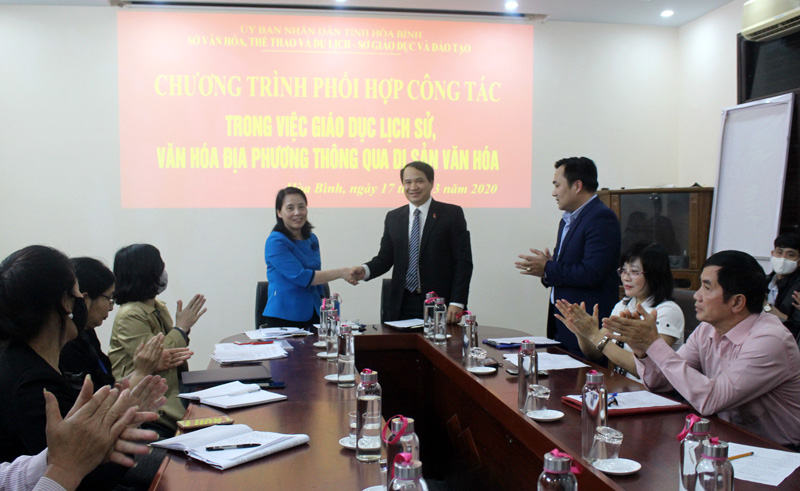
(HBO) – Hoa Binh’s Department of Culture, Sports and Tourism and Department of Education and Training on March 17 signed a joint cooperation programme on educating people about local history and traditional culture through cultural heritages.
 Leaders of Hoa Binh’s Department
of Culture, Sports and Tourism and Department of Education and Training sign a
joint cooperation programme on March 17.
Leaders of Hoa Binh’s Department
of Culture, Sports and Tourism and Department of Education and Training sign a
joint cooperation programme on March 17.
The agreement is part of
activities to implement the Ministry of Culture, Sport and Tourism’s project on
improving quality and effectiveness of museum operation in tandem with
developing tourism.
It is expected to
facilitate a closer coordination between the two provincial departments in
enhancing the capacity and effectiveness of their work to educate people on the
province’s history and traditional culture through local cultural heritages.
They will also work
together to provide students with lessons on history and culture at museums and
promote the preservation of historical and cultural values.
The students will be
offered real-world experience to discover local history and cultural, thus
raising their sense of responsibility to protect the historical and cultural
heritages and inspiring their patriotism.
Under the deal, the two
departments will together develop and compile materials and documents
introducing Hoa Binh’s cultural heritages to the students and design field
trips to the museums for the students of different ages.
They will also organise clubs
and classes to teach students about local intangible cultural heritages, such
as folk games and folk singing./.
With an increasingly vibrant and widespread emulation movement aimed at building cultured residential areas and cultured families, Yen Thuy District has been making steady progress toward improving both the material and spiritual well-being of its people, while fostering a civilized, prosperous, beautiful, and progressive community.
Once lacking recreational spaces and community facilities, Residential Group 2 in Quynh Lam Ward (Hoa Binh City) has recently received attention for the construction of a new, spacious, and fully equipped cultural house. The project followed the model of state support combined with public contributions in both labor and funding.
The "All people unite to build cultural life" movement, which has been effectively integrated with Kim Boi district’s socio-economic development goals, is fostering a lively spirit of emulation across local residential areas, hamlets, villages, public agencies, and enterprises. In addition, through the initiative, traditional cultural values are being preserved and promoted, while community solidarity and mutual support in poverty reduction and economic development are being strengthened.
A working delegation of the Hoa Binh provincial People’s Committee led by its Permanent Vice Chairman Nguyen Van Toan on June 11 inspected the progress of a project to build the Mo Muong Cultural Heritage Conservation Space linked to tourism services in Hop Phong commune, Cao Phong district.
Born and growing in the heroic land of Muong Dong, Dinh Thi Kieu Dung, a resident in Bo town of Kim Boi district, in her childhood was nurtured by the sweet lullabies of her grandmother and mother. These melodies deeply imprinted on her soul, becoming an inseparable part of her love for her ethnic group's culture. For over 20 years, this love for her hometown has driven Dung to research, collect, and pass down the cultural values of the Muong people to future generations.
In the final days of May, the Ethnic Art Troupe of Hoa Binh Province organized performances to serve the people in remote, mountainous, and particularly disadvantaged areas within the province. These were not just ordinary artistic shows, but they were the meaningful journeys aimed at spreading cultural values, enhancing the spiritual life of the people and contributing to the preservation of ethnic minority cultural identities.



 Leaders of Hoa Binh’s Department
of Culture, Sports and Tourism and Department of Education and Training sign a
joint cooperation programme on March 17.
Leaders of Hoa Binh’s Department
of Culture, Sports and Tourism and Department of Education and Training sign a
joint cooperation programme on March 17.